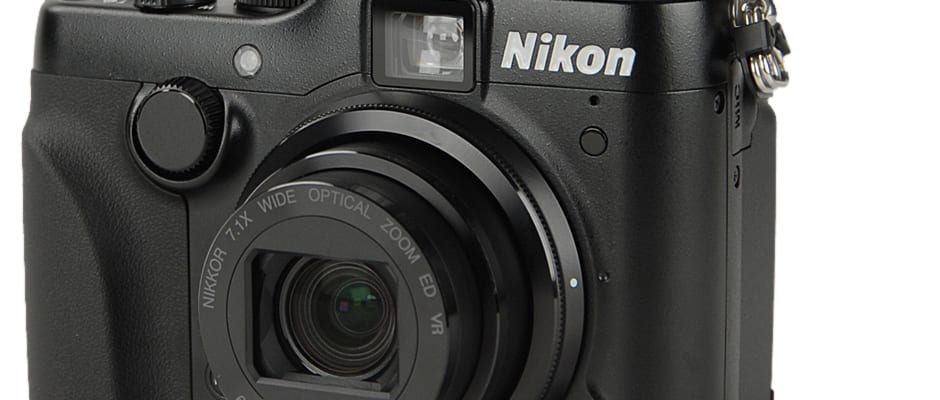Introduction
Read on to see if the P7100 has what it takes to be king of the enthusiast mountain. The P7100 is available now in black, at an MSRP of $499.
Design & Usability
{{section_header}}{{section.name}}{{/section_header}}
This brick is built for work, not for looks or for comfort, but the controls are mostly in the right places.
This brick of a camera is built for doin’ work, not for looking pretty or feeling comfy. It’s all function over form, and there’s nothing approachable about it. The surplus of buttons and dials should intimidate most novice photographers. Even experienced shooters might be forgiven for thinking that Nikon crammed every button they could dream up onto the relatively compact chassis, without regard for aesthetics or handling.
Yet the setup mostly works. The grip could be bigger, but it provides enough leverage over the well-balanced body to feel fairly comfortable in hand. Most of the buttons are comfortably situated, aside from the front-mounted dial and the Fn1 button. The viewfinder could stand to be bigger, too; the camera is already huge by compact standards, so an extra half-inch won’t change much. It’s bulky, but roughly the same weight as the smaller Fujifilm X10. Nikon wisely packaged it with a shoulder strap for easy toting and periods of prolonged shooting.
Finally, like most compact cameras today, the P7100 has two main ports: a mini-HDMI connection, and a micro-USB jack that doubles as an A/V component output. Just about all of the most common reasons for connecting a camera to anything should be covered by these two ports.
{{photo_gallery "Front Photo", "Back Photo", "Sides Photo", "Top Photo", "Bottom Photo", "Lens Photo", "Lens Photo 2", "3D Lens Photo", "Media Photo", "Easy Mode Photo", "Manual Controls Photo 1", "Manual Controls Photo 2", "Zoom Photo", "Zoom Photo 2", "Ease of Use Photo", "Battery Photo", "LCD Photo 1", "LCD Photo 2", "EVF Photo 1", "EVF Photo 2", "Ports Photo 1", "Ports Photo 2", "Ports Photo 3", "Ports Photo 4", "Ports Photo 5", "Ports Photo 6", "Handling Photo 1", "Handling Photo 2", "Handling Photo 3", "Handling Photo 4", "Buttons Photo 1", "Buttons Photo 2", "Buttons Photo 3", "Box Photo"}}
Features
{{section_header}}{{section.name}}{{/section_header}}
An articulating screen, an optical viewfinder, and a long-reaching lens define this well-built camera.
Not too many compacts come with built-in optical viewfinders anymore, but the P7100 is one of the few and proud that does. It’s a tunnel-style finder, so it covers about 80% of the lens’ actual field of view—not perfect, but that’s one of the compromises that comes with the territory. It does zoom along with the lens, which is very helpful, and a diopter adjustment dial will please many users as well.
Playback mode, which has a dedicated button, offers most of what we generally hope to see. The interface should be straightforward to anyone with a bit of digicam experience. Any of the command dials can cycle through the photos, and though they aren’t nearly as sensitive to commands as they should be, they’re still easier to use than a directional pad.
The in-camera editing suite is limited, but can come in handy in certain situations. Presumably, the hands-on enthusiast users who are most likely to buy the P7100 have some sort of editing software and a decent home workstation, so this suite might not see a lot of use anyway.
Performance
{{section_header}}{{section.name}}{{/section_header}}
The P7100 delivers solid core performance for an entry-level system camera.
The P7100 can take a fine photo. It reproduces reasonably accurate colors—not as true-to-life as most system and DSLR cameras, or even some low-end point-and-shoots, but closer than its high-end peers. Most shades come close to the ideal coloring, but bright yellow is much greener and paler than it should be, and that one sickly tone throws off the average.
Noise performance is generally strong too. The P7100's 1/1.7" CCD sensor is about 40% larger than the sensors in typical point-and-shoots. That extra size helps procure clean images throughout most of the ISO range, though the P7100 predictably struggles more in low light. This camera also resolves an excellent amount of detail for a compact. It produced some of the best sharpness and chromatic aberration results we’ve seen from any RAW-capable point-and-shoot out there (and we’ve tested all of the big ones at this point). Unfortunately, distortion drags down the overall score somewhat.
Lastly, be aware that nobody should confuse the P7100 as a purpose-built movie-making machine. Video is merely an extra feature here—fine, but not extraordinary. Since the P7100 is built around a sluggish CCD sensor, resolution is limited to 720p at a cinematic 24 frames per second.
Conclusion
{{section_header}}{{section.name}}{{/section_header}}
The Nikon P7100 is on a mission.
The Nikon P7100 is on a mission to be everything that photo enthusiasts have come to expect from a high-end compact: It has a bigger sensor than most compacts, an optical viewfinder, heaps of dials and direct-access controls, and the option to shoot in RAW format.
Those individual factors all add up to a great camera. Image quality is excellent, with beautifully rendered details and accurate colors. Aside from Nikon’s bizarre choice to disable distortion control by default (and completely exclude it from Auto mode), and aside from soft, desaturated results at the height of the ISO range, we can’t find much to complain about.
The P7100 is a great camera for patient, experienced photographers. It’s capable of shooting fantastic outdoor photos, but it needs a little extra attention to detail and some hands-on care to do it. Thus, the participatory P7100 should be a nice fit for nature, landscape, and long-exposure photographers; these types are often content alongside a tripod, carefully framing shots and pondering the right settings with care—waiting patiently for the right moment to shoot.
Science Introduction
{{section_header}}{{section.name}}{{/section_header}}
The P7100's overall image quality is excellent, with beautifully rendered details and accurate colors. Distortion is a real menace, though, and the camera flails a bit in low light. Read on to find out more about this camera's performance results.
Color & Sharpness
{{section_header}}{{section.name}}{{/section_header}}
Reasonably accurate colors by default, plus plenty of adjustable settings and customizable profiles
The P7100 reproduces reasonably accurate colors. Neutral proved to be the most accurate color mode, producing a minimum color error of 3.13 at 90% saturation. We like to see a color error of 3.0 or less, and 90% is the very low end of what we consider to be acceptable saturation, but the overall score is decent. Most shades come close to the ideal coloring, but bright yellow is much greener and paler than it should be, a sickly tone that throws off the overall average.
Sharpness performance was even stronger. We measured an average of about 1590 horizontal lw/ph and 1680 vertical lw/ph (MTF50) across the wide, middle, and telephoto focal lengths. That places the P7100 among the sharpest shooters in the advanced compact class, ahead of the Canon G12 and Fujifilm X10, and a length behind the Canon S100 and the Olympus XZ-1.
We're sure that a great lens and a solid sensor are behind the impressive sharpness score, but every camera gets a bit of help from its JPEG processor too. That said, we noticed just a tiny hint of artificial pixel sharpening along some edges, most notably at the wide angle toward the periphery of the frame—but it's subtle and tastefully applied. Plus, sharpening is user-adjustable; we shot our test photos with the Neutral color mode (the most accurate), and we set sharpening to 2 by default (on a scale of 0 to 6)—there's room to fiddle with the intensity in both directions.
{{photo_gallery "Science Section 1 Images"}}
Noise Performance
{{section_header}}{{section.name}}{{/section_header}}
With ample light, photos are very crisp, but at high ISOs images become softer and grainier.
Noise performance is generally strong. The P7100 is built around a 1/1.7" CCD sensor, about 40% larger than the sensors found in typical point-and-shoots. The extra size helps produce clean images throughout most of the ISO range. Up toward the higher settings, the processor adds a dose of noise reduction to keep noise levels in check, but shots retain a decent amount of detail without becoming too grainy. Our chief concern is that colors begin to lose their saturation around ISO 800.
Predictably, the P7100 shows less noise in bright light than in low light. We measured an average of just 0.9% noise across all ISO levels at 3000 lux, maxing out at 1.3%, and 1.04% noise at 60 lux with a maximum of 1.5%.
{{photo_gallery "Science Section 2 Images"}}
Resolution & Distortion
{{section_header}}{{section.name}}{{/section_header}}
Fantastic resolution for a compact camera, soured somewhat by poor default distortion control
The P7100 resolves an excellent amount of detail for a compact camera, with some of the best sharpness and chromatic aberration results we've seen from any RAW-capable point-and-shoot, but distortion drags down the overall score, unfortunately.
By default, the P7100 shoots wildly distorted photos. Our test JPEGs looked like reflections of a funhouse mirror. All cameras suffer from distortion, and almost all of them automatically correct the problem with in-camera processing—but not the P7100. We measured a whopping 2.55% barrel distortion at the wide angle, and a still-obvious 1.58% and 1.27% pincushion effect at the mid-range and telephoto focal lengths, respectively.
In-camera distortion control is optional, though, so problems with distortion can be straightened out. The trouble is that this option is turned off by default, and it's only available in manual modes, therefore any quick snapshots taken in auto mode will be considerably warped. Challenges like this are part of why we only recommend this camera to patient, experienced photographers. Distortion can be fixed in Photoshop or RAW converter software, but that's a time consuming process—probably more so than setting up a great shot in Program or Manual mode in the first place.
{{photo_gallery "Science Section 3 Images"}}
Meet the tester
Liam manages features and news coverage for Reviewed.com. Formerly the editor of the DigitalAdvisor network, he's covered cameras, TVs, personal electronics, and (recently) appliances. He's a native Bostonian and has played in metal bands you've never heard of.
Checking our work.
Our team is here to help you buy the best stuff and love what you own. Our writers, editors, and experts obsess over the products we cover to make sure you're confident and satisfied. Have a different opinion about something we recommend? Email us and we'll compare notes.
Shoot us an email

